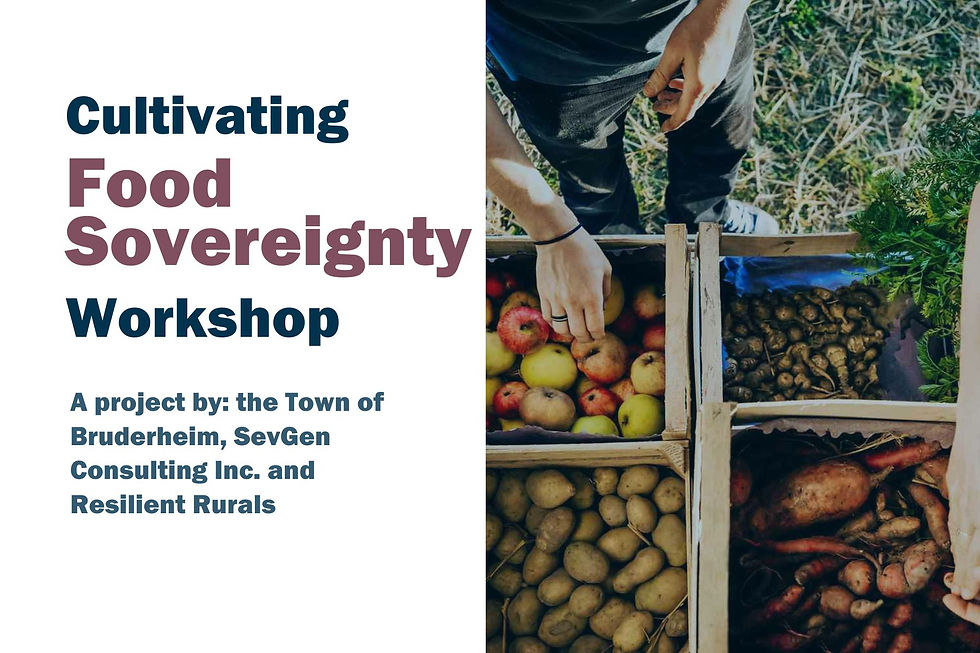Resilient Rurals Feature: Prairie Climate Centre Short Film
- clairekroening
- Mar 4, 2022
- 3 min read
Updated: Oct 6, 2023
praLocal adaption leaders share how collaboration, perseverance and dedicated climate adaptation funding will lead Prairie municipalities to resilience
ClimateWest, in collaboration with the Prairie Climate Centre, launched a short film featuring climate adaptation leaders across municipalities in the Canadian Prairies. Resilient Rurals was thrilled to be a part of this project with Jill Yanch, Director and Resilient Rurals founder, speaking to the significance of the collaborative approach taken by our three partner communities in building resilience against shared climate risks.
Jill Yanch on the collaborative, small town approach
“Much of the work related to climate change adaptation has been done in cities and that adaptation is going to look very different for small communities."
Resilient Rurals was born as a collaborative project between Bruderheim, Gibbons, and Lamont, three small municipalities in Alberta’s Industrial Heartland facing similar climate change impacts. The Town of Bruderheim leads the project, which focuses on environmental, social, and business continuity priorities. On the challenges felt by residents in the region, Yanch explains, “like other areas, we’ve seen more hot days and more significant storms as well. Also, seeding and harvesting crops have been very difficult. It’s been felt very deeply in the agricultural community here.”

“Collaboration with other communities the same size was very helpful to see how we can share resources and pool our knowledge and look for those common risks.”
Resilient Rurals is bolstering the capacity for each partner to adapt by creating adaptation plans, strategies and tools that can be implemented in the communities. Currently, this extra capacity is funded by the Adaptation Resilience Training program, a cost-shared initiative delivered by the University of Alberta and supported by Natural Resources Canada’s Building Regional Adaptation Capacity and Expertise program and Alberta Environment and Parks.
Barriers to implementation: the need for more inclusive and widespread funding streams
Prairie Climate Centre explains that implementation of adaptation plans can be challenging for many Prairie communities. These challenges are largely due to the fact that there are currently not enough dedicated funding streams and resources available to do so. And this is undeniably the case for smaller-sized communities; even with the funding that is available, smaller communities have a difficult time tapping into the pot, as they often must compete with larger city projects for grant funds.
“Often, when we talk about climate change adaptation we talk about climate; we don’t talk about other things that would impact a municipality’s ability to respond to climate,” says Yanch.
Trevor Donald from the Town of Churchill explained, “few municipalities really have the tools available to them to incorporate climate change options in their municipal operations.” Donald says it’s critical to ensure the leadership and decision-making in a municipality is working and that necessary tools, funding and resources are made available. “A municipality with a suite of options like that—however big or small they are—can achieve so much more than how it’s currently being done.”

In the short film Prairie Communities Adapting to Climate Change, frontline adaptation planners from five Prairie communities speak about the work underway and the future paths they envision for Prairie resilience.
Resilience and adaptation tips from local leaders
So how do people working in climate adaptation in small communities find the motivation to keep going in an under-funded environment?
Start where you are; it’s important to start somewhere
Make it community-based by engaging community members to learn about their climate change experiences to reflect their stories in your community’s adaptation
Find your champions that can work in your community, organization and the political sphere
Use the tools that exist like ICLEI’s many tools and other resources available through organizations like Resilient Rurals, ClimateWest, Prairie Climate Centre, and Climate Atlas of Canada
Learn from each other by reviewing other municipality’s plans and sitting down with changemakers to have important conversations
Collaborate with similar size communities, as is being done through the Resilient Rural’s partnership between Bruderheim, Gibbons and Lamont
Don’t get discouraged; change doesn’t happen overnight, but adaptation work has critical, long-term impact
Read ClimateWest's blog post: Community Action: How the Prairies are Adapting to Climate Change
.png)



Comments